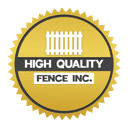
Chain link fences are stalwart guardians of our properties, providing security, demarcation, and privacy. However, just like any other structure, they require care and maintenance to uphold their integrity over time. In this guide, we delve into the essentials of maintaining your chain link fence to ensure its longevity and functionality.
First and foremost, regular inspection forms the cornerstone of fence maintenance. Check for signs of wear and tear such as rust, loose fittings, or bent posts. Addressing these issues promptly can prevent further deterioration and prolong the life of your fence. Additionally, keeping vegetation trimmed around the fence line can prevent damage and maintain its aesthetic appeal. With these simple yet effective tips, you can ensure your chain link fence stands strong for years to come.
Regular Inspection: Identifying Wear and Tear
Regular inspections are the backbone of effective chain link fence maintenance. By routinely examining your fence, you can quickly identify signs of wear and tear such as rust, corrosion, or loose fittings. Pay close attention to areas where metal meets the ground, as these are particularly susceptible to rust. Look for any signs of damage or weakness in the chain links themselves, as well as in the supporting posts and rails. Catching these issues early allows you to address them promptly, preventing further deterioration and extending the lifespan of your fence.
Rust Prevention and Treatment Techniques
Rust can be a formidable adversary for chain link fences, but with the right prevention and treatment techniques, you can keep your fence looking great for years to come. Here’s how:
- Regular Cleaning: Ensure your fence stays free of dirt and debris by washing it with soapy water and a brush at least once a year. This helps prevent moisture buildup, which can accelerate rust formation.
- Apply Rust Inhibitors: Treat your fence with a commercial rust inhibitor to create a protective barrier against corrosion. These products typically contain chemicals that react with rust, converting it into a more stable compound and preventing further oxidation.
- Protective Coatings: Consider applying a rust-resistant coating to your fence, such as paint or vinyl. These coatings not only add a pop of color to your fence but also provide a durable barrier against moisture and corrosion.
- Galvanization: Opt for galvanized steel fencing, which is coated with a layer of zinc to provide excellent corrosion resistance. Galvanized steel fences are highly durable and can withstand exposure to harsh weather conditions.
- Prompt Repairs: If you notice any signs of rust or corrosion on your fence, address them promptly to prevent further damage. Use a wire brush to remove surface rust, then apply a rust converter or inhibitor to stop corrosion in its tracks.
Securing Loose Fittings and Bolts
Loose fittings and bolts can compromise the stability and security of your chain link fence. During your regular inspection, check all fittings, bolts, and connectors to ensure they are tight and secure. Use a wrench or screwdriver to tighten any loose bolts, and replace any missing or damaged fittings as needed. Pay special attention to gate hinges and latches, as these are common areas for loosening over time. By keeping all fittings securely fastened, you can maintain the structural integrity of your fence and prevent potential safety hazards.

Repairing Bent or Damaged Posts
The posts of your chain link fence provide crucial support and stability, so it’s essential to address any damage promptly. If you notice any posts that are bent, leaning, or otherwise damaged, they should be repaired or replaced as soon as possible. Depending on the extent of the damage, you may be able to straighten bent posts using a fence post puller or similar tool.
However, severely damaged posts may need to be removed and replaced entirely. Take care to properly set new posts in concrete footings to ensure they are stable and secure. By promptly repairing damaged posts, you can prevent further issues and prolong the life of your fence.
Maintaining Tension: Checking and Adjusting the Chain Link
Proper tension is essential for the functionality and appearance of your chain link fence. Over time, the chain link fabric may become loose or saggy, compromising the security and aesthetics of the fence. Regularly check the tension of the chain link fabric by pressing down on it with your hand. It should feel taut and firm, with minimal give.
If you notice any areas of excessive slack, you’ll need to adjust the tension by tightening the tension bands or adding tension wire. Be sure to evenly distribute tension throughout the fence to prevent uneven sagging. By maintaining proper tension, you can keep your chain link fence looking neat and secure.
Clearing Vegetation: Preventing Damage and Overgrowth
Vegetation can pose a threat to the integrity of your chain link fence if left unchecked. Overgrown plants and vines can exert pressure on the fence, causing it to sag or lean over time. Additionally, vegetation growing in close proximity to the fence can trap moisture against the metal, accelerating rust and corrosion.
Regularly trim back any vegetation that encroaches on your fence line, keeping it clear of plants and debris. Consider installing a weed barrier or applying herbicide along the fence line to prevent regrowth. By keeping vegetation under control, you can protect the structural integrity of your fence and prolong its lifespan.
Seasonal Maintenance: Addressing Weather-Related Challenges
As the seasons change, your chain link fence faces different weather-related challenges that can affect its integrity and appearance. Here’s how to address these issues effectively:
- Winter: Heavy snowfall and freezing temperatures can cause posts to shift or heave out of the ground, compromising the stability of your fence. Inspect posts after winter storms for signs of movement and promptly realign or reinforce them as needed.
- Spring: Spring showers can lead to moisture buildup and potential rust formation on metal components. Clean the fence thoroughly to remove any debris or dirt that can trap moisture, and apply a protective coating to prevent rust and corrosion.
- Summer: Intense heat and UV radiation can cause metal components to expand and contract, leading to loosening and warping. Check for signs of heat damage, such as warped or discolored metal, and address any issues promptly to prevent further damage.
- Fall: Falling leaves and debris can accumulate around the fence, trapping moisture and promoting rust formation. Keep the area around the fence clear of debris by regularly raking leaves and removing any buildup.
- Year-Round: Regardless of the season, it’s essential to maintain proper tension in the chain link fabric to prevent sagging and ensure the security of your fence. Regularly check and adjust tension as needed, paying close attention to areas prone to sagging.
Enhancing Durability with Protective Coatings
Applying a protective coating to your chain link fence can significantly enhance its durability and lifespan. There are various coating options available, including paint, vinyl, and galvanization. Paint can add a pop of color to your fence while providing a protective barrier against rust and corrosion. Vinyl coatings offer superior resistance to moisture and UV damage, making them ideal for coastal or high-humidity areas. Galvanization involves applying a layer of zinc to the metal surfaces, providing excellent corrosion resistance.
Choose a coating that suits your aesthetic preferences and environmental conditions, and be sure to apply it according to the manufacturer’s instructions. By investing in a protective coating, you can ensure your chain link fence remains strong and resilient for years to come.
Addressing Corrosion: Tips for Coastal or High-Humidity Areas
Coastal areas and regions with high humidity present unique challenges for chain link fence maintenance due to increased exposure to moisture and salt air. These conditions can accelerate corrosion and rust formation, compromising the integrity of the fence. To combat corrosion in coastal or high-humidity areas, it’s essential to take proactive measures such as applying a corrosion-resistant coating or choosing materials specifically designed for marine environments.
Stainless steel or aluminum chain link fences are particularly well-suited to coastal regions, as they offer superior resistance to corrosion. Additionally, regular cleaning and maintenance are crucial for removing salt deposits and preventing rust buildup. By addressing corrosion proactively, you can protect your chain link fence from damage and ensure its longevity in challenging environments.
Long-Term Care Strategies for Maximum Lifespan
Maintaining a chain link fence is an ongoing process that requires regular care and attention. In addition to the specific maintenance tasks outlined above, there are several long-term care strategies you can employ to maximize the lifespan of your fence.
Establishing a regular maintenance schedule and sticking to it can help prevent issues from escalating and ensure your fence remains in top condition year after year. Consider keeping a detailed record of maintenance tasks performed, including inspections, repairs, and treatments. This can help you track the condition of your fence over time and identify any patterns or trends that may require attention.
Maintaining your chain link fence is essential for ensuring its longevity, functionality, and aesthetic appeal. By following the tips and strategies outlined above, including regular inspection, rust prevention, securing loose fittings, and addressing weather-related challenges, you can keep your fence in top condition for years to come. Additionally, proactive measures such as clearing vegetation, applying protective coatings, and addressing corrosion in coastal or high-humidity areas can further enhance the durability of your fence. Remember to establish a regular maintenance schedule, keep detailed records of maintenance tasks, and seek professional assistance when needed. With proper care and attention, your chain link fence can continue to serve as a reliable and resilient barrier around your property.
For all your fencing needs and expert advice on maintaining your chain link fence, contact High Quality Fence at 209-815-9015 or email us at info@highqualityfence.com. Our team of professionals is dedicated to providing high-quality fencing solutions and ensuring the longevity of your investment. Don’t wait until issues arise—take proactive steps today to preserve the integrity of your chain link fence.


